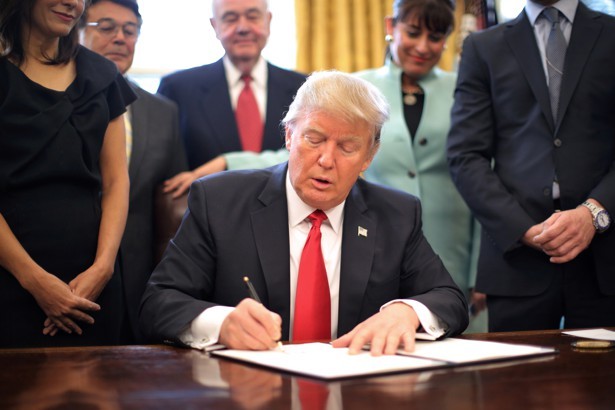Trump’s Executive Orders: A Closer Look
February 23, 2017
In the very short time that Donald J. Trump has been head of the U.S. government, there have been many drastic changes in the law.
With 12 executive orders already signed as of Feb. 21, it would be unwise to be unaware of what each one entails for the future of America.
Executive Order 13765- Repeal of the Affordable Care Act
This was the first of many acts following Trump’s inauguration, calling for the repeal of the Affordable Care Act initiated by Barack Obama during his presidency. The order also proposes that for the federal government to communicate more with state level governments when creating nation-wide acts regarding health care.
Executive Order 13766- Expediting Environmental Reviews and Approvals for High Priority Infrastructure Projects
E.O. 13766 basically sets up a new system to quickly start new infrastructure projects and allows any governor or cabinet member to dictate whether a project is ‘high priority’. The order does not, however, allow governors to completely disregard the previously established laws in their state.
Executive Order 13767- The Wall
This is the Executive order demands that the wall shall be erected on the border between the United States and Mexico. The wall will be manned by “adequate personnel” who will be able to detain any person attempting to cross the border illegally. The order also calls an expedited decision as to whether said apprehended individuals may stay in the United States.
Executive Order 13768- Tightening Immigration
This is the second order signed by Trump that focuses on illegal aliens, pushing immigration officials to be more strict about current immigration laws. It also provides support to any and all individuals who have been caused harm by “removable aliens”. Finally, this order promises to cut off any and all government funding to jurisdictions that don’t comply with immigration laws to the full extent.
Executive Order 13769- The Muslim Ban
‘The Muslim Ban’, as it’s come to be called, suspends all entry into the united states by immigrants and nonimmigrants from “countries or areas of concern” for 90 days following the signing of the order. Additionally, the refugee program in the US is to be halted for the 120 days while the head of the program decides what new hoops refugees will have to jump through before entering the country. After the 120 days are over, only 50,000 refugees may enter the US between then and the end of the fiscal year. To put that into perspective, the previous refugee allowance was nearly 110,000 a year– more than double what it is now.
Executive Order 13770- Ethics Pledge
From now on, any and all US Government officials will have to take this pledge which dictates what they, ethically, cannot do. For example, once an government employee has terminated their job, they are not allowed participate in any lobbying activities that in relates to what they did in the government.
Executive Order 13771- Controlling Regulatory Costs
At first, this order seems unassuming and rather confusing. Basically, it aims to control the us budget by instructing agencies that they must repeal two existing regulations if they decide to make a new one. Additionally, the new regulation must not cost more than the previous two regulations did.
Executive Order 13772- Filing for Bankruptcy
Order 13772 claims to “prevent taxpayer-funded bailouts,” meaning that there will possibly more regulations in place to prevent large companies going bankrupt by supplying them with taxpayer money.
Executive Order 13773- Enforcing Federal Law
This order plans to strengthen the enforcement of federal law “in order to thwart transnational criminal organizations and subsidiary organizations”, or take stronger actions against street gangs and criminal activity It also enforces wider communication between federal agencies so that they may accomplish this goal with more efficiency. It promises not to interfere with any current laws in any given state or region.
Executive Order 13774- Protecting Officers of the Law
This allows citizens to be tried for any attempt to hurt Federal, State, tribal, or local law enforcement officers. The order hopes to improve communication between the federal level and officers spread across the US and evaluate existing federal laws protecting officer to see if what changes need to be made. After that review, suggestions can be made to President Trump and, if warranted, those suggestions can be made into laws.
Executive Order 13775- Backup Attorney General
Who assumes the duties of the Attorney General if they (and the Deputy Attorney General, the Associate Attorney General, and any officers designated by the Attorney General) were to suddenly become unable to perform their duties? According to this order, the United States Attorney for the Eastern District of Virginia would assume all duties previously assumed by the Attorney General, given that he or she was previously eligible to be the Attorney General.
Executive Order 13776- The Task Force
The most recent order signed by our president commands the acting Attorney General to create a task force charged with coming up with ideas to reduce crime, develop these ideas into strategies, and identify problems with existing laws that don’t effectively reduce crime and other items relating to the reduction of crime rates in the US. The task force will be dissolved after the completion of their objectives previously mentioned.
It is important for Americans to understand how these changing laws will affect our daily lives and what we can do to support or challenge them. President Donald Trump has signed 12 executive orders to do what he assumes are good things. Our job, as citizens of the United States, is to understand these laws and what they mean for us.



